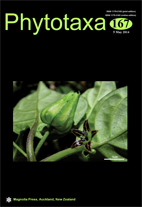Abstract
When describing Tritomaria camerunensis Arnell (1958: 64), Arnell based it on more than one gathering (Byström 35b and 50a) and it is thus invalid according to ICN Art. 40.2 (McNeill et al. 2012), a rule effective from 1 January 1958 saying that “indication of the type ... can be achieved by reference to an entire gathering” and Ex. 1 explicitly states that. This error was overlooked by Váňa (1982) who selected a “lectotype” out of Byström’s collection. However, that did not validate the name. In order to be available for the forthcoming world checklist of hornworts and liverworts (Söderström et al., in prep.) the taxon is here validated. As Arnell’s name is invalid, the description here is technically a new taxon. Schuster (1969: 639) did mention the close affinity to Tritomaria exsectiformis (Breidler 1894: 321) Loeske (1909: 13) “this may represent a disjunct phase of T. exsectiformis” but Váňa (1982) preferred to keep them separate until more material was studied. However, when the taxon needs to be validated, we prefer to do so at subspecific level. The new subspecies differs from. subsp. exsectiformis in larger size of plants (mostly 2–2.5 cm long vs. 1.2–2.0 cm long), constantly prostrate, never ascending shoots, dorsally secund, mostly bilobed leaves (trilobed leaves rare, only on the top of shoots), somewhat smaller and longer cells (up to 20 × 30–40 μm) than is the average cells size of Tritomaria exsectiformis subsp. exsectiformis, and rounded, angular to polygonal, 1–2–celled (vs. constantly 2–celled, irregularly polygonal to pyriform) gemmae.

